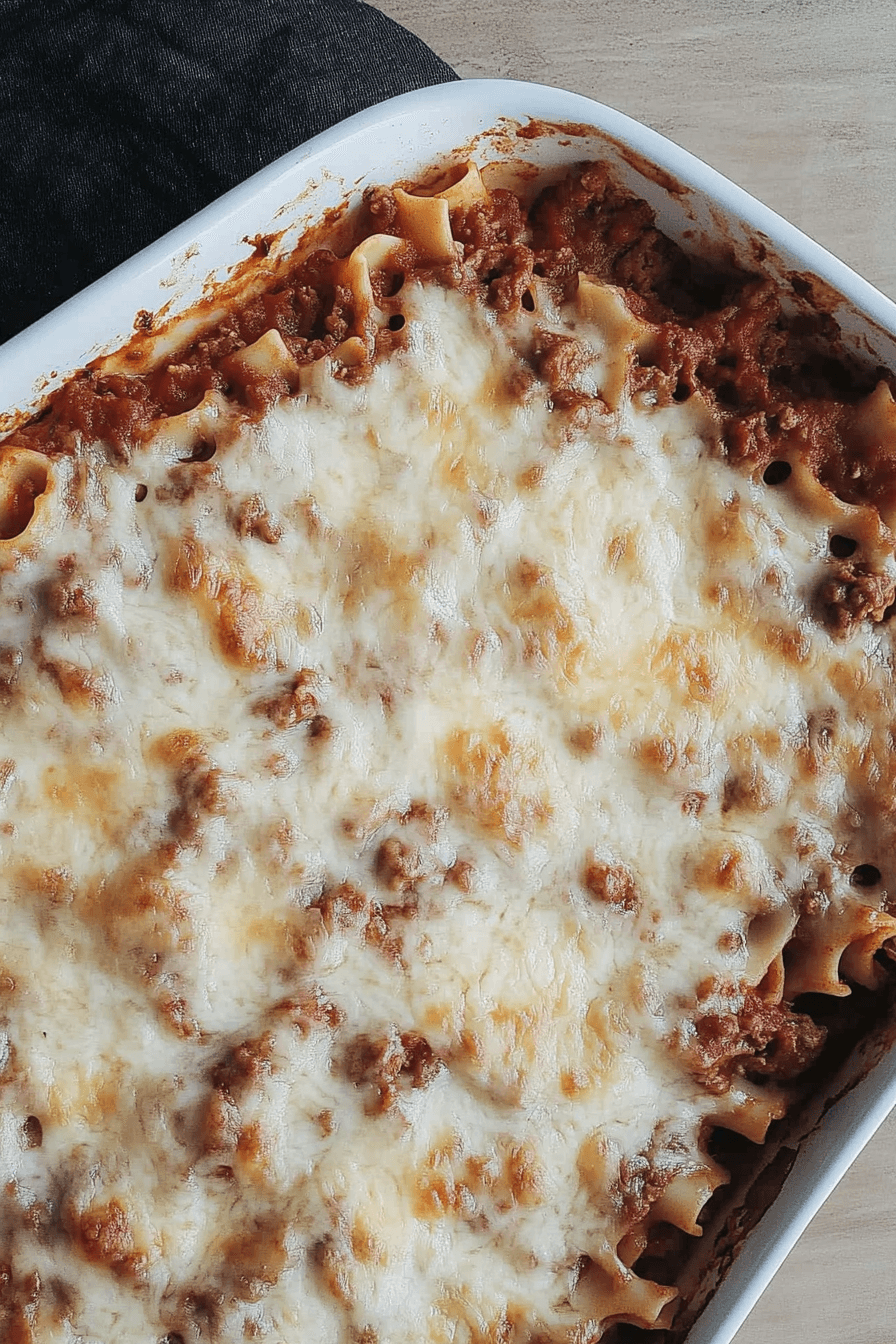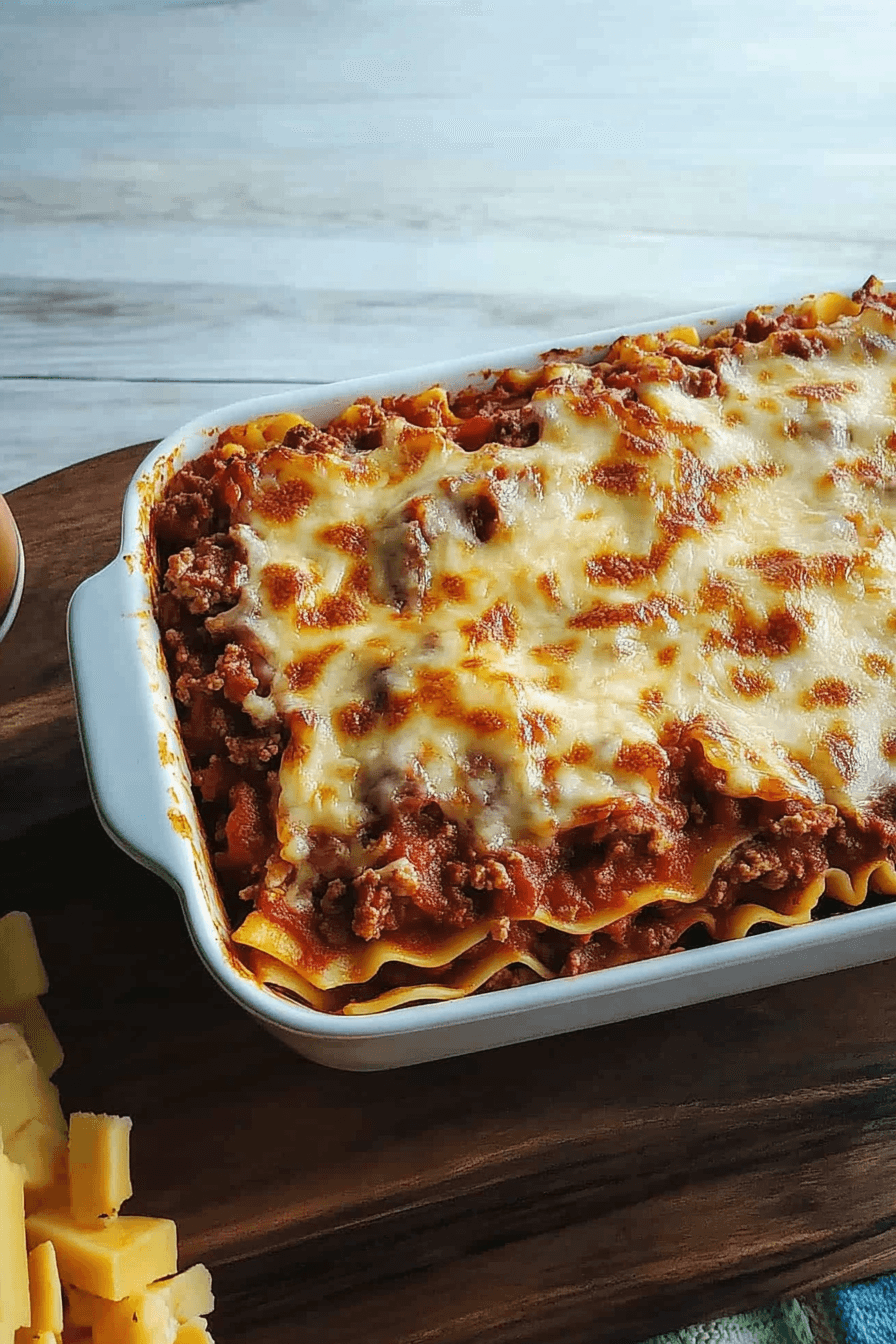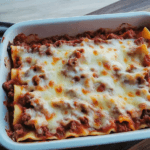Introduction to Beef Lasagna
Beef Lasagna, a classic Italian delight, brings a delightful combination of rich flavors and hearty textures to your dining table. This dish is not only a feast for the senses but also a versatile choice for busy home cooks and food enthusiasts alike. Its layers of pasta, succulent beef sauce, and gooey cheese are meticulously crafted to transport you to an Italian evening filled with warmth and comfort. Whether you’re a seasoned cook or new to the culinary world, this recipe is designed to inspire joy in your cooking journey. Learn more about the history of lasagna here and see how this timeless classic continues to captivate food lovers everywhere.
Benefits and Advantages of Beef Lasagna
Crafting a Beef Lasagna is more than just cooking; it’s an opportunity to create a masterpiece that caters to your personal taste and dietary preferences. This dish’s ease of preparation makes it perfect for busy parents and professionals looking for a quick yet satisfying meal. With its high protein content and rich flavors, Beef Lasagna not only nourishes the body but also provides a comforting meal that brings families closer together. Furthermore, its versatility means you can customize it with various ingredients, like substituting beef for vegetables for a vegetarian twist. Discover more culinary inspirations with our Lasagna Soup recipe that captures the essence of comfort in a bowl. Embrace the joy of family gatherings, and make memorable meals with this universally loved dish.

Ingredients Overview
Essential Ingredients for Beef Lasagna
- Ground Beef: 1 pound. Provides the rich, savory element central to beef lasagna.
- Italian Sausage: 1/2 pound, optional. Adds spice and depth of flavor to the meat sauce.
- Lasagna Noodles: 9-12 pieces, depending on the pan size. Creates the classic layers.
- Ricotta Cheese: 15 ounces. For a creamy and smooth texture in the layers.
- Mozzarella Cheese: 2 cups shredded. Melted mozzarella brings delightful gooeyness.
- Marinara Sauce: 24 ounces. Preferably homemade for freshness, or a high-quality store-bought option.
- Onion: 1 medium, diced. Adds a subtle sweetness and texture to the sauce.
- Garlic: 3 cloves, minced. Enhances flavor with its aromatic qualities.
- Herbs: 1 tsp each of oregano and basil for authentic Italian taste.
- Egg: 1 large. Helps to bind the cheese mixture.
- Parmesan Cheese: 1/4 cup grated. For added flavor and savory depth.
Dietary Substitutions to Customize Your Beef Lasagna
Whether you’re accommodating dietary preferences or simply have alternate ingredients on hand, here are some substitutions to customize your beef lasagna:
- Vegan and Gluten-Free Options:
- Replace meat with lentils or mushrooms for a vegan option.
- Use gluten-free lasagna noodles if you’re avoiding gluten.
- Opt for vegan cheeses or nutritional yeast to mimic the cheesy flavor.
- Low-Calorie Substitutions:
- Use ground turkey or chicken instead of beef for a lighter version.
- Choose low-fat ricotta and mozzarella to reduce calorie count.
How to Prepare the Perfect Beef Lasagna: Step-by-Step Guide
Creating an authentic Italian beef lasagna requires attention to detail, but with this step-by-step guide, you’ll capture the essence of a classic Italian kitchen.
First Step: Preheat your oven to 375°F (190°C). As the oven warms, bring a large pot of salted water to a boil. Cook the lasagna noodles according to package instructions until al dente. Once done, drain and lay them flat on a clean surface to avoid sticking.
Second Step: In a large skillet over medium heat, add a drizzle of olive oil. Cook the diced onion until translucent, then add in minced garlic, stirring frequently until aromatic. Add the ground beef and Italian sausage. Brown the meat, breaking it apart with a spoon, and season with oregano and basil for that fragrant touch.
Third Step: Once the meat is browned, stir in your marinara sauce. Simmer on low heat for about 10 minutes, allowing the flavors to meld harmoniously.
Fourth Step: In a separate bowl, combine ricotta cheese with one beaten egg and grated Parmesan cheese. Mix until smooth. This mixture helps hold layers together beautifully.
Fifth Step: Now, assemble your lasagna. Start by spreading a thin layer of meat sauce at the bottom of a 9×13-inch baking dish. Follow with a layer of noodles. Then, evenly spread half of the ricotta mixture over the noodles. Sprinkle some shredded mozzarella over this layer. Repeat the layering process: meat sauce, noodles, ricotta, mozzarella.
Sixth Step: End with a final layer of noodles topped with the remaining meat sauce and a generous coverage of mozzarella cheese.
Seventh Step: Cover the dish with aluminum foil, preventing cheese from sticking by tenting it slightly in the center. Bake in the preheated oven for 25 minutes.
Eighth Step: Remove the foil and let it bake for another 15 minutes until the top turns golden brown, and the cheese melts into a bubbling perfection.
Ninth Step: Once baked, allow it to rest for 10 minutes before slicing. This resting period helps the layers set, making it easier to serve.
And there you have it, a perfectly layered and richly flavorful beef lasagna, ready to be enjoyed with loved ones around your dinner table. For an enhanced dining experience, consider pairing this dish with a refreshing Greek salad or some garlic bread for a delightful culinary journey.

Mastering Beef Lasagna: Advanced Tips and Variations
Creating a mouthwatering beef lasagna requires some finesse, but fear not, as these advanced tips will guide you to perfection. First, always pre-soak or pre-cook your lasagna noodles according to the package instructions unless you’re using the no-boil variety. This ensures even cooking. Next, consider the balance of flavors; the key is to achieve a harmonious blend between the meat, cheese, and tomato sauce. A dash of red wine in the meat sauce can add depth and complexity.
Tips for a Perfect Cheese Layer
When it comes to the cheese layer, use a mixture of ricotta, mozzarella, and Parmesan for the best flavor and texture combo. Blend the ricotta with a beaten egg and some Parmesan cheese to achieve a creamy consistency that binds well when cooked. Don’t be afraid to experiment with different cheeses like asiago or fontina for a unique twist.
Adding Vegetables and Herbs
To incorporate more nutrients, consider adding thinly sliced vegetables such as zucchini, mushrooms, or baby spinach between the layers. Fresh herbs like basil and oregano enhance the freshness of flavors; add them just before serving to maintain their bright, aromatic qualities. Additionally, ensure that your sauce simmers gently to marry all the flavors without reducing it to a watery consistency.
Exploring Flavor Variations
If you’re adventurous, you’ll love trying new variations. Substitute ground beef with spicy Italian sausage or a mix of ground pork and turkey for a different flavor profile. For a smoky touch, incorporate a bit of smoked paprika into the sauce, or add a hint of nutmeg to the béchamel. Vegetarian guests? Swap out the meat entirely for hearty lentils or mushrooms.
How to Store Beef Lasagna: Best Practices
Storing beef lasagna properly ensures that each reheated slice tastes just as delicious as the first. Once your lasagna has cooled, cover it tightly with aluminum foil or transfer it to an airtight container for refrigeration. It will last up to three days in the fridge. If you’re making a larger batch, you might consider freezing the lasagna.
Freezing Lasagna
For freezing, cut your lasagna into individual portions and wrap each piece in plastic wrap followed by a layer of foil. This helps prevent freezer burn. Store the wrapped pieces in a zip-top freezer bag or an airtight container. Properly stored, frozen lasagna will retain its quality for up to two months. When ready to eat, thaw the lasagna in the refrigerator overnight for an even reheating process.
Reheating Tips
To reheat, preheat your oven to 350°F (175°C). If you’re using frozen lasagna, allow it to come to room temperature first for even heating. Cover the lasagna with foil to prevent it from drying out, and bake for approximately 30 minutes or until heated through. Alternatively, you can also reheat single servings in the microwave using a microwave-safe dish, covered loosely with a microwave lid or parchment paper.
Maintaining Quality
Revitalize your lasagna with a sprinkle of fresh Parmesan or a drizzle of olive oil after reheating to bring back that freshly-cooked taste. These storage and reheating techniques will not only preserve the flavor and texture but will also ensure that you always have a comforting meal ready at hand.

Nutritional Value of Beef Lasagna
Understanding the nutritional value of beef lasagna can guide you in making informed dietary choices, whether you’re preparing it for a family dinner or considering it for a special occasion. Beef lasagna is a hearty meal recognized for its delicious layers and comforting flavors, but it is also important to be aware of its nutritional makeup.
Calories and Macronutrients
On average, a serving of beef lasagna, roughly 1/8th of a full dish, contains between 350 to 500 calories. This meal is known for being a rich source of protein, with each portion offering approximately 20 to 30 grams, making it ideal for those focusing on protein intake. Additionally, carbohydrates are present in the range of 30 to 40 grams per serving due to the pasta layers.
Fats and Other Nutrients
Beef lasagna contains varying levels of fats, generally derived from the ground beef and cheese. A typical serving may have around 15 to 25 grams of fat, with a necessary balance between saturated and unsaturated fats. It’s worth noting that beef lasagna is also a good source of calcium, provided by the cheese layers, aiding in maintaining healthy bones.
Dietary Considerations
It’s crucial for diet-conscious individuals to consider portion control and the type of ingredients used, as these factors can significantly influence the dish’s nutritional profile. By substituting leaner meats or incorporating more vegetables, the calorie count can be adjusted to better fit a low-calorie diet plan.
As with many delicious Italian dishes, beef lasagna offers both indulgence and nourishment, balancing flavorful satisfaction with a hearty nutritional profile. To explore more diverse and nutritious recipes, check out related dishes like the creamy potato soup.
FAQs: Frequently Asked Questions About Beef Lasagna
1. What is the best type of cheese to use in beef lasagna?
The best cheese for beef lasagna is typically a combination of ricotta, mozzarella, and Parmesan. This trio provides a creamy texture and rich flavor profile. Mozzarella melts into a gooey layer, ricotta adds creaminess, and Parmesan gives a sharp, savory punch.
2. Can I use raw lasagna noodles, or should they be cooked first?
Both options are viable. Many modern recipes now leverage no-boil or oven-ready lasagna noodles, which are designed to cook perfectly during baking, absorbing moisture from the sauce. However, traditional recipes often recommend boiling fresh lasagna noodles until al dente before layering.
3. How can I prevent my beef lasagna sauce from becoming too watery?
To prevent a watery sauce, ensure that you simmer your beef sauce long enough to reduce the water content before assembling the lasagna. Additionally, draining excess grease from the cooked beef and using thicker tomato sauce help maintain a perfect consistency. This technique highlights how attention to detail can prevent common lasagna pitfalls.
4. What is the role of béchamel sauce in a classic beef lasagna recipe?
Béchamel sauce plays a critical role in authentic Italian beef lasagna by adding a rich, creamy layer that balances the acidity of the tomato sauce. It complements the meat and cheese, enhancing the overall flavor and texture. This ingredient makes lasagna truly delicious and smooth.
For a deeper understanding of lasagna’s traditional elements, explore resources like the history of lasagna and what makes this dish so beloved globally.
Print
Beef Lasagna Recipe Like an Italian
- Total Time: 1 hour 30 minutes
Description
🍽️ Indulge in a hearty, cheesy Beef Lasagna packed with rich flavors, high protein, and comforting warmth—perfect for family dinners! ❤️🔥
🥄 Easy to make, customizable, and great for leftovers, this classic dish satisfies cravings while bringing everyone together at the table! 🍕✨
Ingredients
Lasagna noodles
Ground beef
Italian sausage (optional)
Olive oil
Onion, chopped
Garlic, minced
Marinara sauce
Tomato paste (optional)
Dried oregano
Dried basil
Salt
Black pepper
Ricotta cheese
Egg
Parmesan cheese, grated
Mozzarella cheese, shredded
Fresh parsley (optional, for garnish)
Instructions
1. Preheat the oven to 375°F.
2. Cook the lasagna noodles according to the package instructions, then drain and set aside.
3. In a large skillet, cook ground beef (and Italian sausage if using) over medium heat until browned.
4. Add chopped onions and minced garlic to the meat and sauté until softened.
5. Stir in marinara sauce, oregano, and basil, then simmer for 10-15 minutes.
6. In a bowl, mix ricotta cheese, an egg, parmesan cheese, and some mozzarella cheese.
7. Spread a layer of meat sauce at the bottom of a baking dish.
8. Place a layer of cooked lasagna noodles over the sauce.
9. Spread a layer of the ricotta cheese mixture over the noodles.
10. Add another layer of meat sauce over the cheese mixture.
11. Repeat the layering process until all ingredients are used, finishing with a layer of meat sauce and mozzarella cheese on top.
12. Cover the baking dish with aluminum foil and bake for 30 minutes.
13. Remove the foil and bake for another 15-30 minutes until bubbly and golden brown.
14. Let the lasagna cool for about 10-15 minutes before slicing.
15. Serve hot and enjoy!
Notes
Let the lasagna rest for at least 10-15 minutes after baking to help it set and make slicing easier.
Use a mix of ground beef and Italian sausage for a richer and more flavorful meat sauce.
Prepare lasagna ahead of time and refrigerate or freeze it for an easy meal later.
- Prep Time: 30
- Cook Time: 60
- Category: Main Course
- Method: Baking
- Cuisine: Italian

